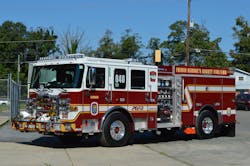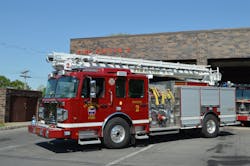The Apparatus Architect: Fleet Services Management
Merriam-Webster defines experience as “practical knowledge, skill or practice derived from direct observation or participation in events or particular activity.” Many aspects of firefighting rely on both experience and training to permit personnel to operate safely with confidence during emergency incidents.
Experience can be gained in many fashions. This includes reaching out to subject matter experts who can provide guidance and recommendations that are based on their activities and observations.
With this in mind, The Apparatus Architects reached out to apparatus fleet managers who work on a daily basis with different aspects of fire apparatus, including fleet replacement, preventative maintenance, and oversight of both front-line and reserve units, for their insight. Richard Riley, who is the fire apparatus manager for the Prince George’s County, MD, Fire/EMS Department (PGFD), and Zachary Smith, who is the deputy chief of maintenance for the Syracuse, NY, Fire Department (SFD), provided particularly intriguing responses to the questions that we posed to the apparatus fleet managers. Their insights and observations in the realm of managing the day-to-day operations of large apparatus fleets serve as practical advice that can be applied to any department’s vehicle fleet.
The departments
Prince George’s County encompasses 499 square miles of urban, suburban, rural and industrial areas and is protected by 45 fire stations. The stations are staffed with 977 career firefighters and paramedics and 1,063 volunteer firefighters and EMS providers.
The PGFD’s Apparatus Maintenance Division maintains, coordinates and services 654 pieces of apparatus, including 99 engines, 24 trucks, 11 heavy duty rescue squads, 117 ambulance and medic units, and 283 command and support vehicles. These units are a combination of ownership by the career department and the volunteer organizations. Regardless of ownership, the Apparatus Maintenance Division and the fire chief are responsible for all of the maintenance and repairs.
The SFD operates from 11 stations, including one that’s located at Syracuse Hancock International Airport. The department operates with nine two-piece engine companies, four truck companies, a rescue company, a squad company, and three district chiefs. That setup includes 95 vehicles, including 32 vehicles in the heavy fleet as well as 63 support and staff vehicles.
Life cycles and spares
THE APPARATUS ARCHITECTS: What is the planned life cycle replacement for front-line apparatus that are in your department’s fleet, including engines, trucks, rescue squads and medic units?
RILEY: The current planned replacement schedule for the career fire department is 10 years for an engine, 15 years on trucks, 15 years on heavy rescue and 6 years on ambulances. After these times, these units will serve in a reserve status or be assigned to a slower company. A large number of the paramedic engines, ambulances and medic units experience a very high call volume, and they are monitored for repairs and mileage, which might make them candidates for early replacement in the schedule.
SMITH: Our engines are slated for 10 years of front-line, with 5 years of reserve service. Trucks are similar, with the rescue company and ambulance units providing seven years of front-line and seven years reserve. Due to the high frequency of runs, the mini pumpers are replaced after eight years of front-line service and after four years reserve.
THE APPARATUS ARCHITECTS: How many spare vehicles or reserve pieces of apparatus does your department have to support front-line engines, trucks and rescue squad units?
RILEY: The department is working diligently through the efforts of Fire Chief Tiffany Green to ensure that the department has reserve units that are dependable, of a lower age than previous administrations and fully equipped. This is to ensure that out-of-service (OOS) times are as low as possible for the switchover of units in case of a mechanical failure. Currently in the reserve fleet, we have 7 engines, 2 trucks, 1 squad, and 20 ambulances/medic units.
SMITH: The SFD has four spare and two recall engines, three spare and one recall truck, one spare rescue and five spare mini pumpers. The recall apparatus are fully equipped and would be staffed by off-duty personnel when required. Along with the spare units, the recall apparatus are housed at our fire stations.
THE APPARATUS ARCHITECTS: With respect to your engines and trucks, what is the frequency of routine preventative maintenance inspections and work? Is this based on specific criteria, i.e., time, engine mileage, engine hours, etc.?
RILEY: We currently service all engines and trucks twice a year for preventative maintenance. We follow these timeframes regardless of mileage or engine hours. With some of our higher run units, we will pull them in periodically to address any issues or minor fixes. When we have them in the shop, we will go over the rigs to ensure that all systems are operating correctly and see if there is an issue or problem that we can get ahead of to help prevent a future OOS issue.
SMITH: The engines are scheduled for both light and heavy preventative maintenance along with annual pump and aerial testing. The light and heavy inspections are six months apart, alternating. Due to our call volume and weather, most apparatus visit us at the shop an additional two or three times per year. We will accomplish any of that scheduled maintenance when the apparatus are in the shop.
The trucks have different aerial hour requirements for maintenance. We have found that every three months for aerial checks and lubrication and twice yearly full aerial inspection, washes and grease match our hourly usage nicely. That’s on top of the scheduled chassis maintenance, which is just like the schedule for engines.
Mini pumpers are on a three-month rotation, as they respond to our EMS alarms.
Each heavy chassis that’s in the fleet is equipped with a Graco grease jockey that does 30 different lubrication points from front to back of the vehicle.
THE APPARATUS ARCHITECTS: What is the baseline for in-service time for your front-line apparatus compared with OOS time for preventative maintenance and warranty work? What have you done to accomplish this benchmark, and what recommendations would you offer to departments that struggle with OOS time?
RILEY: We measure units’ OOS, the OOS impact to the entire fleet operationally and the availability of reserve units in days. The time and day of the OOS time is tracked immediately by the assigned apparatus maintenance technicians. We track this for in-house repairs and at our vendors.
We have daily contact with all of our vendors, so they can provide updates on each piece of equipment that’s being repaired at their facility. This helps us to track the repair progress and in regard to when the unit might be back in service.
One of the things that the standardization of the engines, trucks and ambulances has provided us is our in-stock inventory of parts for those units. We have taken an approach to keep a large number of parts, pieces and components in stock on our shelves. We have found that the standardization has allowed us to keep those parts heavily stocked for our like units, unlike before, when we had no commonality in parts, pieces or designs on the apparatus and had to stock a wide variety of parts. This has allowed us to be able to quickly identify the issue with the rig, retrieve the part from our in-house inventory and get the rig back on the road. This has also helped with our road calls, as the service trucks are stocked with the common parts and pieces that break or fail, and those people can get the unit back in service rapidly.
We have also worked with our local dealers to allow our mechanics to replace parts on the rig that are under warranty from our stock, then have the dealer replace that part back in our shop/stockroom from their facility. This helps us lower OOS times for the rigs, when they otherwise might have to go back to the dealer for some minor warranty issues or problems.
OOS times and rigs are very closely monitored daily, if not hourly, by the staff at the Apparatus Maintenance Division and the field duty chiefs. This is to ensure proper protection for our community and to make sure we have units available in case of breakdowns or failures.
SMITH: We have worked our way back to 85 percent in-service time, the rest of the time being 10 percent scheduled maintenance and 5 percent unscheduled maintenance or warranty work. Over the past decade, the department has aggressively purchased new apparatus or refurbished existing to “as new” to get the average age of front-line apparatus down to 10 years.
We have also filled our roster with as many mechanics as possible and sent them to or brought in fire apparatus repair classes.
Furthermore, we have held manufacturers accountable for their warranties.
If you don’t have the staffing that we are afforded, increasing the speed of your buying and your preventative maintenance cycle should decrease your apparatus downtime.
The cost of new apparatus continues to increase and in some instances is outpacing the available financial resources to fund the planned, replacement schedule.

